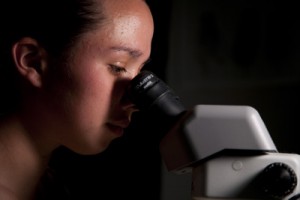
Ten colleges and universities will use a total of $123 million in stimulus funds to build scientific facilities that will help campus researchers study coral reef ecosystems, experimental physics, quantum science, and a range of other fields.
A mix of state funds and $10.3 million from the American Recovery and Reinvestment Act will help the University of Maryland build an advanced quantum physics laboratory, where sensitive scientific tools and materials will be kept for researchers.
Officials at the University of Maryland’s College Park campus announced last month that the Recovery funds—also known as the federal stimulus bill passed by Congress last year—will be matched with $5.2 million in state and university funds.
The university is one of many nationwide that have applied for and won funding from the $787 billion stimulus legislation. Ten colleges and universities will use a total of $123 million in stimulus funds to build scientific research facilities.
Nova Southeastern University in Ft. Lauderdale, Fla., will use $15 million in stimulus funds to construct the Center of Excellence for Coral Reef Ecosystem Science. Coral reefs near the Nova Southeastern campus account for more than 71,000 jobs and contribute $6 billion annually to the local economy, making university research a critical piece of Nova’s mission.
The university’s coral reef center will cost $30.6 million, according to the U.S. Commerce Department’s National Institute of Standards and Technology (NIST), which awarded the stimulus money to each campus.
More than half of the $27.8 million needed to build the University of Pittsburgh’s planned science facility dedicated to studying large-scale hurricanes and storms. The $15 million in federal funding will help NIST develop the next generation of measurement technology.
Maryland’s Laboratory for Advanced Quantum Science will be built underground and designed to protect measurement equipment that can be affected by even the smallest vibration or change in temperature. The campus’s 21,000-square-foot lab will include cryptography, or the study of sensors and advanced computing.
Construction near the University of Maryland will start later this year and will be completed in 2013, according to a Jan. 8 campus announcement.
“This remarkable laboratory will allow researchers to greatly improve our fundamental understandings of quantum science, with important implications for an array of technologies,” said C.D. Mote, Jr., the university’s president.
Laser are just one of the tools in the planned laboratory that will require a facility that limits nearly undetectable vibrations that could expand or contract a device by “a few billionths of a meter,” according to Maryland’s announcement.
Legislators said using stimulus funds to open a new research facility would create jobs while the country deals with persistent jobs losses each month during the economic downturn.
“This funding is not just a research generator, it is also a jobs generator and an example of how the Recovery Act is continuing to work and create jobs and support economic growth, while investing in our communities,” said Rep. Steny Hoyer (D-Md.), whose congressional district includes the university.
Colleges and universities have applied for tens of millions of dollars in federal stimulus grants designed to expand broadband internet access, arguing that university IT infrastructure makes campuses worthy recipients.
The government announced in August that an initial $4 billion in stimulus loans and grants will be used to connect rural homes to the internet, stimulate interest in getting internet service among groups that don’t use it much, and expand internet access in public locations such as schools and libraries.
More than 2,200 applicants asked for a total of $28 billion in broadband funds during this initial application process–roughly seven times the amount available. Most of the applications proposed building out internet lines to bring broadband access to rural American towns and cities.
The National Telecommunications and Information Administration (NTIA) and the Rural Utilities Service will pick the winning applicants and announce them in November.
A review of colleges and universities that applied for federal broadband grant money showed many campuses vying to provide more computers with broadband web access to local residents, and other schools hoping to establish wide-ranging cloud-computing networks.
The Research Foundation of the State University of New York (SUNY) requested the largest higher-education related grant, asking for $30 million to implement an educational and workforce training program run through a cloud-computing network. Cloud computing allows users access data, applications, and computer programs over a network via large server centers.
The $30 million would be used to purchases hardware and software for an expansive cloud-computing network, curriculum to educate students and workers, and delivery of “community-based educational training programs” to schools and libraries. The application said the program would focus on underrepresented populations.
Clarkson University in Potsdam, N.Y., is one of many schools hoping to use stimulus broadband funds to establish public computer centers in areas where residents have little or no access to high-speed internet service.
The university is requesting $950,590 to build computing centers in 10 local communities, an important step in creating more than 2,000 “wired workers”–entrepreneurs who conduct their business online–by 2019.
The computer centers, which would be spread throughout the Adirondack North Country area, also could become meeting places for business owners and employees using high-speed internet to bolster outreach.
Links:
American Recovery and Reinvestment Act
- Top trends: Improve graduation rates and retention - August 8, 2019
- Learn how this university adopted a successful data-driven strategy for inclusive learning - June 17, 2019
- Stunning: 56 percent of institutions will struggle to meet recruitment targets due to visa, travel restrictions - September 29, 2017

